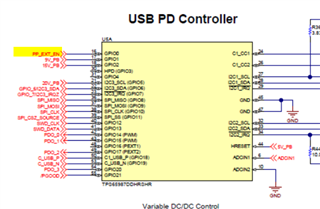Other Parts Discussed in Thread: TPS65987
Hello,
Using the TPS65987EVM and also a custom board with TPS65987D I have unsuccessfully tried to source more than 60W (20V @3A) using a single internal path.
I am using a 5A cable with e-mark I was able to configure a 20V 5A PDO. This PDO is correctly detected by the other side (I am using the sink portion of the USB-C-PD-DUO-EVM) and negotiation for this PDO at 100W is correctly established.

I am using a DC programmable load attached to the USB-C-PD-DUO-EVM and increasing progressively the current load, the source TPS cuts when current load is about 3.3-3.5A. It looks like the Overcurrent Clamp Firmware is not correctly applied for currents above 3A and it ceils at this value.

I am using this firmware in the TPS:
TPS65987_88_F707_10_10.bin
Have you been able to source (not only negotiate) up to 100W using TPS65987 internal power path in your lab? Could you please try to reproduce this test?
Note: I If I use the USB-C-PD-DUO-EVM source and sink sides to do this test, I can increase the current with no problem, even with the default configuration, as the external power path is used in the source TPS when 20V is selected and there is no overcurrent protection for the external path.



 Source Board GPIO 0
Source Board GPIO 0 GPIO on PD
GPIO on PD Power path controlled by GPIO.
Power path controlled by GPIO.
